Fully Solar Residential Energy Community: A Study on the Feasibility in the Italian Context †
Abstract
1. Introduction
2. Methodology
2.1. Renewable Energy Community Model
2.2. Battery Storage Control Strategies
3. Simulation Results
3.1. Parameters and Assumptions
3.2. PV and Battery Sizing
3.3. RECs of Prosumers with 50 % of SP
3.4. Fully Solar RECs
4. Conclusions
- In Italy, PV/BESS systems can be optimally sized to achieve nearly 100% SP by oversizing PV systems to produce three times the annual electricity demand, while using just one-day storage autonomy, which is 1.25 kWh/kWp. Thus, a fully solar community is feasible from a technical standpoint if the energy shared by the prosumers is consumed by another REC member.
- Including consumers in an REC decreases the PBT for prosumers by up to 5 years (1175–1424 €/yr revenue), while allowing consumers to reduce their energy bills by up to 104–248 €/yr (17–37%) % without investing in renewable energy systems. In the analysed case study, the optimal cost-benefit ratio for RECs is achieved with an equal number of consumers and prosumers.
- Among the analysed BESS control strategies, the P2P-C configuration is the most effective for energy sharing, making fully-solar RECs economically viable with the Italian incentive system. Despite current PV/BESS costs, a discounted PBT of 19 years over a 30-year expected lifetime is achievable. Using a centralized battery, which can be funded through crowdfunding, lower capital costs and higher energy shared values are attainable. The P2P-CF management of fully solar RECs with consumers is less profitable than the simple P2P-C but preferable from the grid management point of view, since it reduces the net residual load ramps on the power system.
- The revenue from shared energy incentives is equivalent to a feed-in tariff of 0.023–0.05 €/kWh produced by the PV/BESS residential systems, which is 3.5–7.5 times lower than the 2011 Italian feed-in tariff program. Consequently, REC incentives support the development of fully solar RECs with much lower public funding than single-user installations.
Author Contributions
Funding
Data Availability Statement
Conflicts of Interest
References
- Cuenca, J.J.; Jamil, E.; Hayes, B. State of the Art in Energy Communities and Sharing Economy Concepts in the Electricity Sector. IEEE Trans. Ind. Appl. 2021, 57, 5737–5746. [Google Scholar] [CrossRef]
- Rosado, S.P.; Khadem, S.K. Development of Community Grid: Review of Technical Issues and Challenges. IEEE Trans. Ind. Appl. 2019, 55, 1171–1179. [Google Scholar] [CrossRef]
- Secchi, M.; Barchi, G.; Macii, D.; Moser, D.; Petri, D. Multi-objective battery sizing optimisation for renewable energy communities with distribution-level constraints: A prosumer-driven perspective. Appl. Energy 2021, 297, 117171. [Google Scholar] [CrossRef]
- Secchi, M.; Barchi, G. Peer-to-peer electricity sharing: Maximising PV self-consumption through BESS control strategies. In Proceedings of the 2019 IEEE International Conference on Environment and Electrical Engineering and 2019 IEEE Industrial and Commercial Power Systems Europe (EEEIC/I&CPS Europe), Genova, Italy, 11–14 June 2019; pp. 1–6. [Google Scholar]
- Vicente, S.B.; Cordero, D.M.; Estopiñán, A.L.; Ángel Zorita, L.; Hernandez-Callejo, L. Technical evaluation of European and North American sustainable benchmark scenarios based on renewable Local energy Communities penetration. Sustain. Energy Technol. Assess. 2023, 60, 103556. [Google Scholar]
- Weckesser, T.; Dominković, D.F.; Blomgren, E.M.; Schledorn, A.; Madsen, H. Renewable Energy Communities: Optimal sizing and distribution grid impact of photo-voltaics and battery storage. Appl. Energy 2021, 301, 117408. [Google Scholar] [CrossRef]
- Gruber, L.; Kockar, I.; Wogrin, S. Towards resilient energy communities: Evaluating the impact of economic and technical optimization. Int. J. Electr. Power Energy Syst. 2024, 155, 109592. [Google Scholar] [CrossRef]
- Crowley, B.; Kazempour, J.; Mitridati, L. How can energy communities provide grid services? A dynamic pricing mechanism with budget balance, individual rationality, and fair allocation. Appl. Energy 2025, 382, 125154. [Google Scholar] [CrossRef]
- Liu, C.; Li, Z. Comparison of Centralized and Peer-to-Peer Decentralized Market Designs for Community Markets. IEEE Trans. Ind. Appl. 2022, 58, 67–77. [Google Scholar] [CrossRef]
- Zhang, Z.; Tang, H.; Ren, J.; Huang, Q.; Lee, W.J. Strategic Prosumers-Based Peer-to-Peer Energy Market Design for Community Microgrids. IEEE Trans. Ind. Appl. 2021, 57, 2048–2057. [Google Scholar] [CrossRef]
- Bielig, M.; Kacperski, C.; Kutzner, F.; Klingert, S. Evidence behind the narrative: Critically reviewing the social impact of energy communities in Europe. Energy Res. Soc. Sci. 2022, 94, 102859. [Google Scholar] [CrossRef]
- Caramizaru, E.; Uihlein, A. Energy Communities: An Overview of Energy and Social Innovation; Scientific Analysis or Review, Policy Assessment KJ-NA-30083-EN-N (Online); Joint Research Centre: Luxembourg, 2020. [Google Scholar]
- Standal, K.; Leiren, M.D.; Alonso, I.; Azevedo, I.; Kudrenickis, I.; Maleki-Dizaji, P.; Laes, E.; Nucci, M.R.D.; Krug, M. Can renewable energy communities enable a just energy transition? Exploring alignment between stakeholder motivations and needs and EU policy in Latvia, Norway, Portugal and Spain. Energy Res. Soc. Sci. 2023, 106, 103326. [Google Scholar] [CrossRef]
- Individuazione della tariffa incentivante per la remunerazione degli impianti a fonti rinnovabili inseriti nelle configurazioni sperimentali di autoconsumo collettivo e comunita’ energetiche rinnovabili, in attuazione dell’articolo 42-bis, comma 9, del decreto-legge n. 162/2019, convertito dalla legge n. 8/2020. (20A06224) (GU Serie Generale n.285 del 16-11-2020). Available online: https://www.gazzettaufficiale.it/eli/id/2020/11/16/20A06224/SG (accessed on 20 April 2023).
- IRENA. Renewable Power Generation Costs 2021; Technical Report; IRENA: Masdar City, United Arab Emirates, 2021. [Google Scholar]
- Ghiani, E.; Trevisan, R.; Rosetti, G.L.; Olivero, S.; Barbero, L. Energetic and Economic Performances of the Energy Community of Magliano Alpi after One Year of Piloting. Energies 2022, 15, 7439. [Google Scholar] [CrossRef]
- Cutore, E.; Volpe, R.; Sgroi, R.; Fichera, A. Energy management and sustainability assessment of renewable energy communities: The Italian context. Energy Convers. Manag. 2023, 278, 116713. [Google Scholar] [CrossRef]
- Moncecchi, M.; Meneghello, S.; Merlo, M. Energy Sharing in Renewable Energy Communities: The Italian Case. In Proceedings of the 2020 55th International Universities Power Engineering Conference (UPEC), Torino, Italy, 1–4 September 2020; pp. 1–6. [Google Scholar]
- Mutani, G.; Usta, Y. Design and modeling renewable energy communities: A case study in Cagliari (Italy). Int. J. Sustain. Dev. Plan. 2022, 17, 1041–1051. [Google Scholar] [CrossRef]
- Mariuzzo, I.; Fioriti, D.; Guerrazzi, E.; Thomopulos, D.; Raugi, M. Multi-objective planning method for renewable energy communities with economic, environmental and social goals. Int. J. Electr. Power Energy Syst. 2023, 153, 109331. [Google Scholar] [CrossRef]
- Martirano, L.; Rotondo, S.; Kermani, M.; Massarella, F.; Gravina, R. Power Sharing Model for Energy Communities of Buildings. IEEE Trans. Ind. Appl. 2021, 57, 170–178. [Google Scholar] [CrossRef]
- Ceglia, F.; Marrasso, E.; Martone, C.; Pallotta, G.; Roselli, C.; Sasso, M. Towards the Decarbonization of Industrial Districts through Renewable Energy Communities: Techno-Economic Feasibility of an Italian Case Study. Energies 2023, 16, 2722. [Google Scholar] [CrossRef]
- Secchi, M.; Barchi, G.; Moser, D.; Nassuato, S.; Pellizzari, D.; Costa, A. Energy Sharing Control Strategies: A Benchmark Analysis in a Configurable Italian Demonstrator. In Proceedings of the 8th World Conference on Photovoltaic Energy Conversion, Milan, Italy, 26–30 September 2022; pp. 1509–1513. [Google Scholar]
- Ancona, M.A.; Baldi, F.; Branchini, L.; De Pascale, A.; Gianaroli, F.; Melino, F.; Ricci, M. Comparative Analysis of Renewable Energy Community Designs for District Heating Networks: Case Study of Corticella (Italy). Energies 2022, 15, 5248. [Google Scholar] [CrossRef]
- Barchi, G.; Pierro, M.; Secchi, M.; Moser, D. Residential Renewable Energy Community: A Techno-Economic Analysis of the Italian Approach. In Proceedings of the 2023 IEEE International Conference on Environment and Electrical Engineering and 2023 IEEE Industrial and Commercial Power Systems Europe (EEEIC/ICPS Europe), Madrid, Spain, 6–9 June 2023; pp. 1–6. [Google Scholar]
- Pflugradt, N. Load Profile Generator v11. Available online: https://www.loadprofilegenerator.de (accessed on 20 March 2023).
- ASTAT—Istituto Provinciale di Statistica. Dati Demografici Provincia Autonoma di Bolzano. 2018. Available online: https://astat.provincia.bz.it/it/news-pubblicazioni-info.asp?news{_}action=4{&}news{_}article{_}id=630459 (accessed on 20 March 2023).
- Long, C.; Wu, J.; Zhou, Y.; Jenkins, N. Peer-to-peer energy sharing through a two-stage aggregated battery control in a community Microgrid. Appl. Energy 2018, 226, 261–276. [Google Scholar] [CrossRef]
- IRENA. BTM Batteries 2019. Available online: https://www.irena.org/-/media/Files/IRENA/Agency/Publication/2019/Sep/IRENA_BTM_Batteries_2019.pdf (accessed on 16 November 2023).
- Annual Technology Baseline—Residential Battery Storage. Available online: https://atb.nrel.gov/electricity/2022/residential_battery_storage (accessed on 15 March 2023).
- EnelX Kits. Available online: https://www.enelxstore.com/it/it/prodotti/energia-solare/generazione-stoccaggio-energia/fotovoltaico-e-storage (accessed on 16 November 2023).
- Steckel, T.; Kendall, A.; Ambrose, H. Applying levelized cost of storage methodology to utility-scale second-life lithium-ion battery energy storage systems. Appl. Energy 2021, 300, 117309. [Google Scholar] [CrossRef]
- ARERA. Andamento del Prezzo Dell’energia Elettrica per il Consumatore Domestico Tipo in Maggior Tutela. Available online: https://www.arera.it/dati-e-statistiche/dettaglio/andamento-del-prezzo-dellenergia-elettrica-per-il-consumatore-domestico-tipo-in-maggior-tutela (accessed on 20 March 2023).
- Perez, M.; Perez, R.; Rábago, K.R.; Putnam, M. Overbuilding & curtailment: The cost-effective enablers of firm PV generation. Sol. Energy 2019, 180, 412–422. [Google Scholar]
- Pierro, M.; Perez, R.; Perez, M.; Prina, M.G.; Moser, D.; Cornaro, C. Italian protocol for massive solar integration: From solar imbalance regulation to firm 24/365 solar generation. Renew. Energy 2021, 169, 425–436. [Google Scholar] [CrossRef]
- Decreto Ministeriale 5 luglio 2012—Attuazione Dell’art. 25 del Decreto Legislativo 3 Marzo 2011, n. 28, Recante Incentivazione Della Produzione di Energia Elettrica da Impianti Solari Fotovoltaici (c.d. Quinto Conto Energia). Available online: https://www.gazzettaufficiale.it/eli/id/2012/07/10/12A07629/sg (accessed on 20 November 2023).
- ARERA—Autorità Regolazione per Energia Reti e Ambiente. Disposizioni in Relazione Alla Conclusione del Regime di Scambio sul posto, ai Sensi dell’Articolo 9, Comma 2, del Decreto Legislativo 199/21. Available online: https://www.arera.it/atti-e-provvedimenti/dettaglio/25/78-25 (accessed on 5 March 2025).
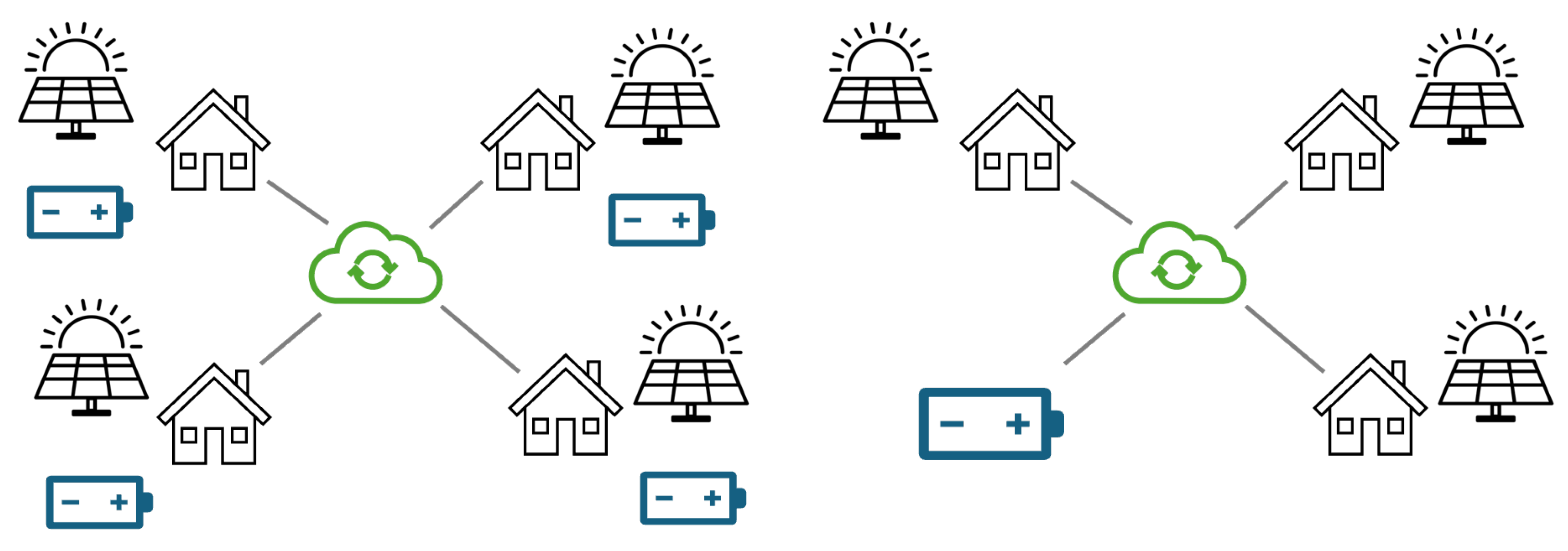
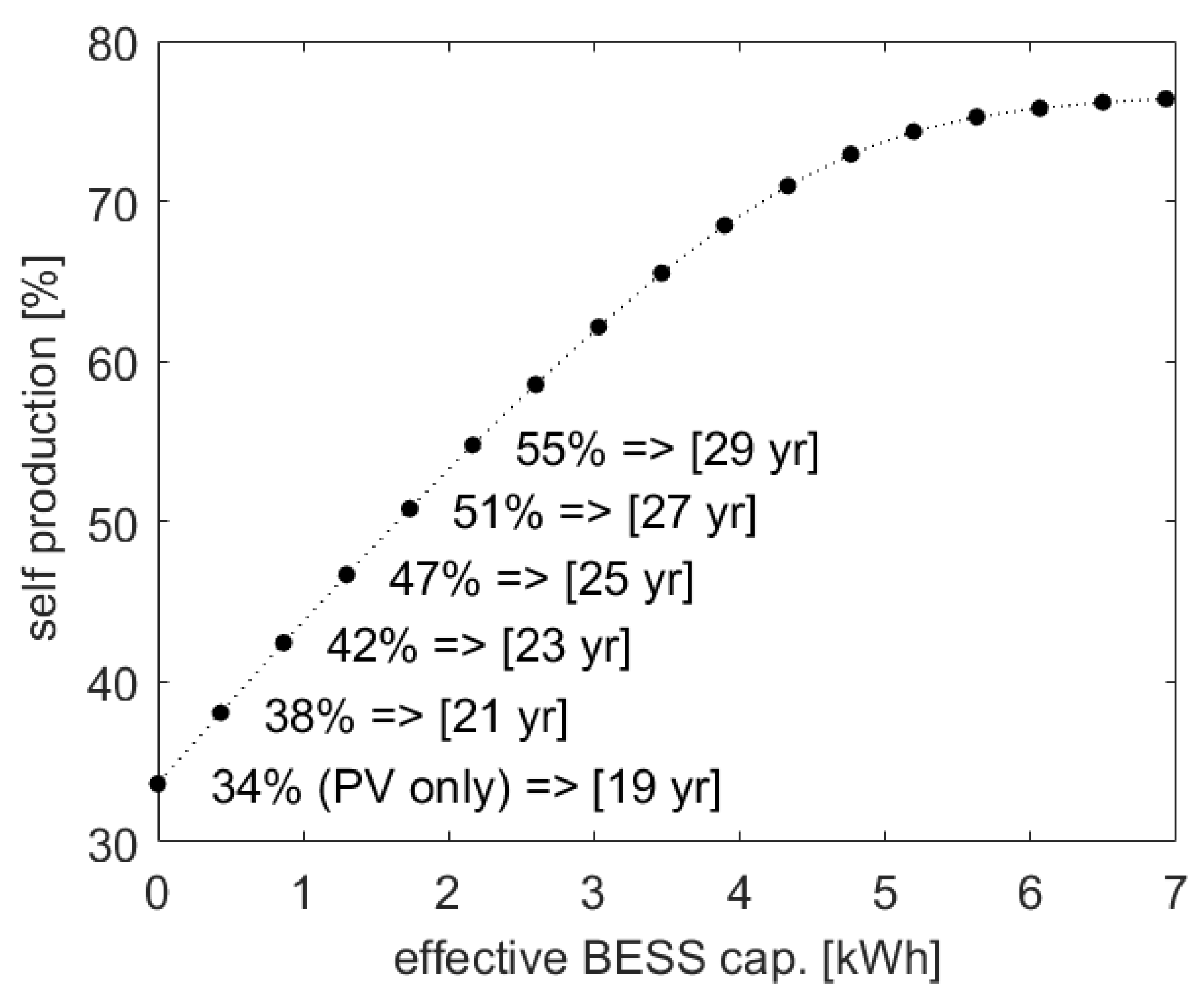
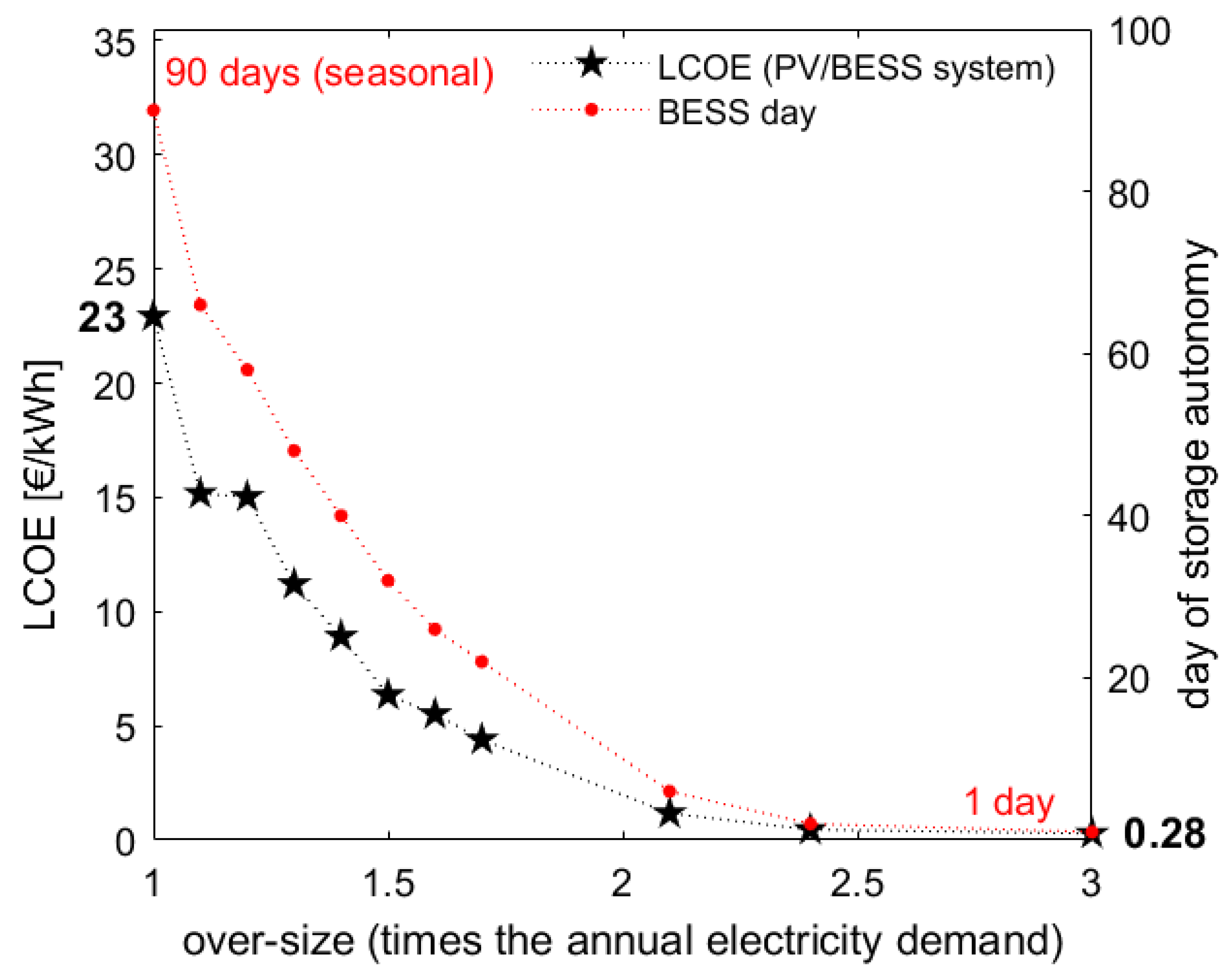
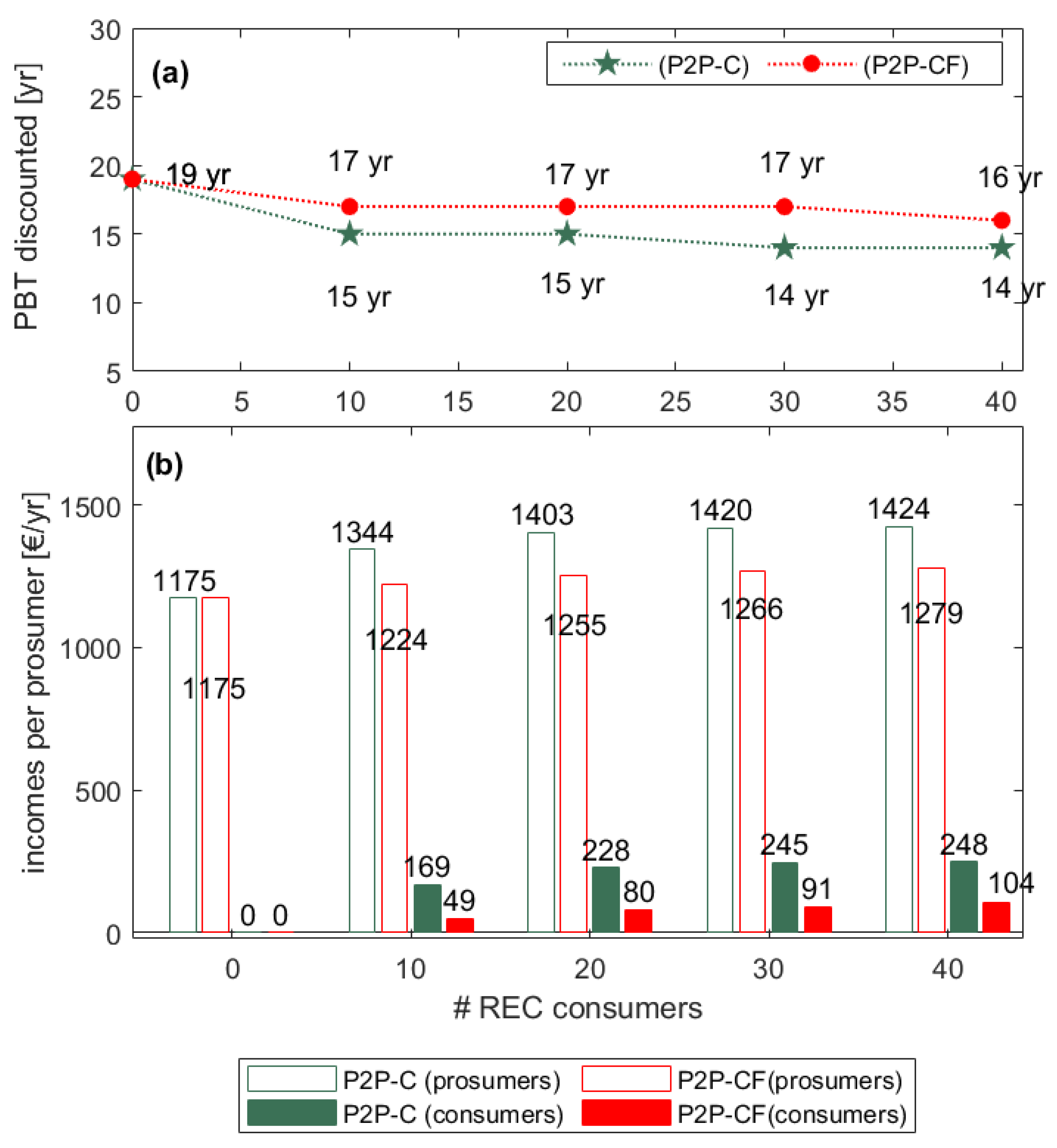
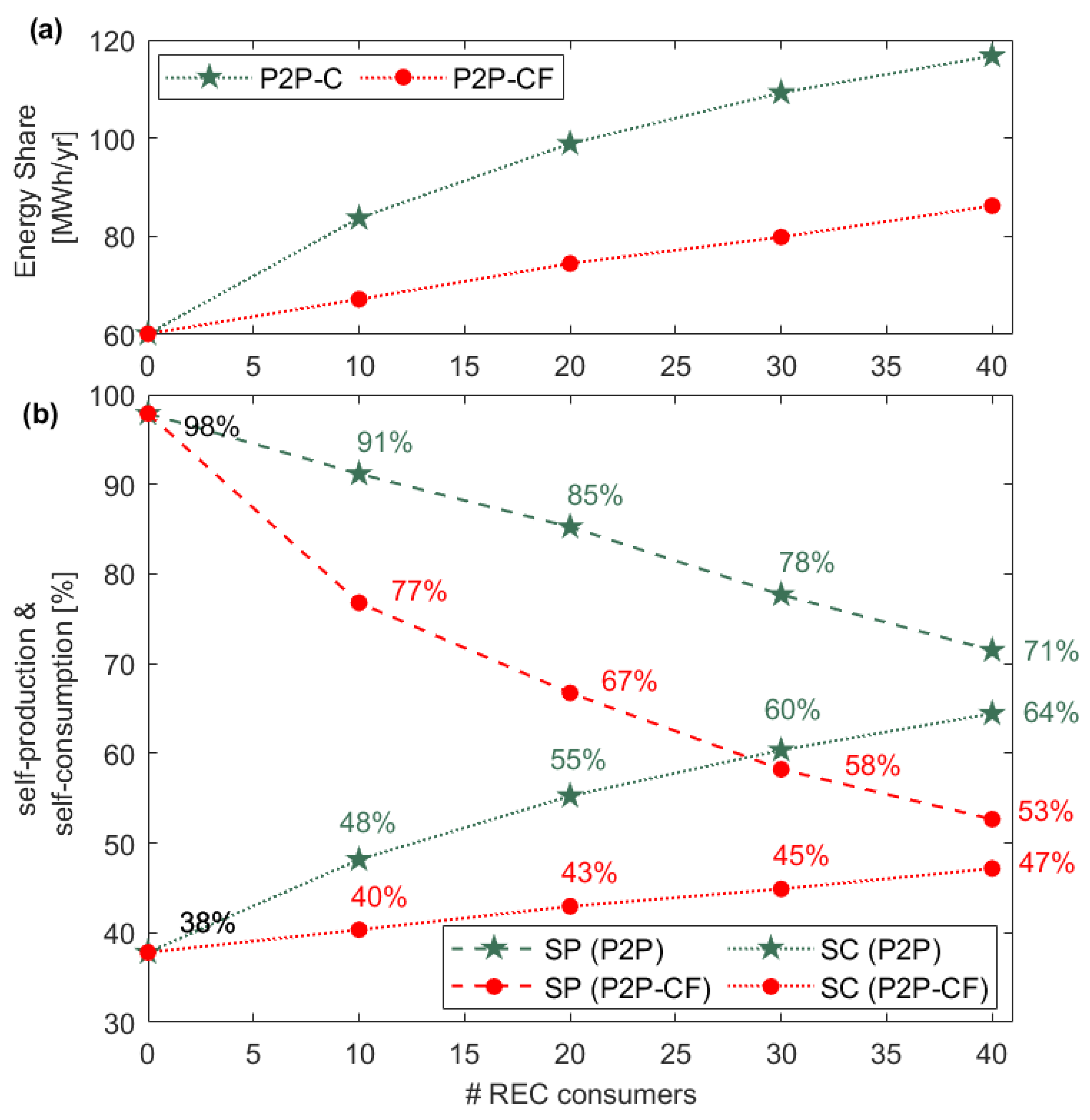

| Variable | Value | |
|---|---|---|
| PV system | CAPEX (<6 kWp) [30,31] | 2500 €/kWp |
| CAPEX (6 kWp < x < 20 kWp) [30] | 1800 €/kWp | |
| OPEX | 1.5*CAPEX | |
| Power loss rate | 0.5%/yr | |
| Lifetime | 30 years | |
| BES system | CAPEX (2–4 kWh) | 1000 €/kWh |
| CAPEX (60–240 kWh) | 800 €/kWh | |
| CAPEX (240–400 kWh) | 640 €/kWh | |
| OPEX fixed cost | 65 €/yr | |
| OPEX variable cost [32] | 3.1 €/MWh | |
| Dept of discharge (DoD) | 80% | |
| Round-trip-efficiency | 90% | |
| Degradation | 1.3%/yr | |
| Lifetime | 5000 life cycle | |
| Replacement [30] | 15 years | |
| Replacement cost [30] | 65% CAPEX | |
| Other costs | Tax rebate every 10 years | 50% |
| Energy sharing incentive [14] | 0.118 €/kWh | |
| Weighted Average Cost Capital | 4% | |
| Cost electricity [33] | 0.21 €/kWh | |
| Sold energy [33] | 0.05 €/kWh |
| # REC Consumers | P2G (MWh/yr) | P2P (MWh/yr) | P2P-C (MWh/yr) |
|---|---|---|---|
| 0 | 0 | 0 | 20 |
| 5 | 2.5 | 7.5 | 22 |
| 10 | 5 | 10 | 25 |
| 20 | 10 | 15 | 30 |
| 30 | 15 | 22 | 35 |
| 40 | 18 | 28 | 35 |
| # REC Consumers | SP (P2G) [%] | SP (P2P) [%] | SC (P2G) [%] | SC (P2P) [%] |
|---|---|---|---|---|
| 0 | 50 | 50 | 50 | 50 |
| 5 | 48 | 46 | 55 | 64 |
| 10 | 44 | 41 | 60 | 64 |
| 20 | 41 | 37 | 64 | 73 |
| 30 | 37 | 34 | 73 | 78 |
| 40 | 34 | 30 | 78 | 84 |
| # REC Consumers | Discounted PBT [yr] | Energy Share (€/kWh) | ||||
|---|---|---|---|---|---|---|
| P2G | P2P | P2P-C | P2G | P2P | P2P-C | |
| 0 | 28 | 26 | 18 | 0.001 | 0.002 | 0.025 |
| 10 | 24 | 21 | 16 | 0.008 | 0.013 | 0.030 |
| 20 | 21 | 18 | 15 | 0.015 | 0.023 | 0.036 |
| 30 | 20 | 18 | 14 | 0.020 | 0.030 | 0.040 |
| 40 | 20 | 17 | 14 | 0.026 | 0.038 | 0.044 |
| # REC Consumers | Revenues Per Prosumer [€/yr] | Revenues Per Consumer [€/yr] | ||||
|---|---|---|---|---|---|---|
| P2G | P2P | P2P-C | P2G | P2P | P2P-C | |
| 0 | 400 | 415 | 480 | 0 | 0 | 0 |
| 10 | 443 | 476 | 531 | 43 | 60 | 51 |
| 20 | 469 | 511 | 561 | 69 | 96 | 81 |
| 30 | 476 | 520 | 568 | 76 | 105 | 88 |
| 40 | 484 | 530 | 576 | 84 | 115 | 96 |
Disclaimer/Publisher’s Note: The statements, opinions and data contained in all publications are solely those of the individual author(s) and contributor(s) and not of MDPI and/or the editor(s). MDPI and/or the editor(s) disclaim responsibility for any injury to people or property resulting from any ideas, methods, instructions or products referred to in the content. |
© 2025 by the authors. Licensee MDPI, Basel, Switzerland. This article is an open access article distributed under the terms and conditions of the Creative Commons Attribution (CC BY) license (https://creativecommons.org/licenses/by/4.0/).
Share and Cite
Barchi, G.; Pierro, M.; Secchi, M.; Moser, D. Fully Solar Residential Energy Community: A Study on the Feasibility in the Italian Context. Energies 2025, 18, 1988. https://doi.org/10.3390/en18081988
Barchi G, Pierro M, Secchi M, Moser D. Fully Solar Residential Energy Community: A Study on the Feasibility in the Italian Context. Energies. 2025; 18(8):1988. https://doi.org/10.3390/en18081988
Chicago/Turabian StyleBarchi, Grazia, Marco Pierro, Mattia Secchi, and David Moser. 2025. "Fully Solar Residential Energy Community: A Study on the Feasibility in the Italian Context" Energies 18, no. 8: 1988. https://doi.org/10.3390/en18081988
APA StyleBarchi, G., Pierro, M., Secchi, M., & Moser, D. (2025). Fully Solar Residential Energy Community: A Study on the Feasibility in the Italian Context. Energies, 18(8), 1988. https://doi.org/10.3390/en18081988








